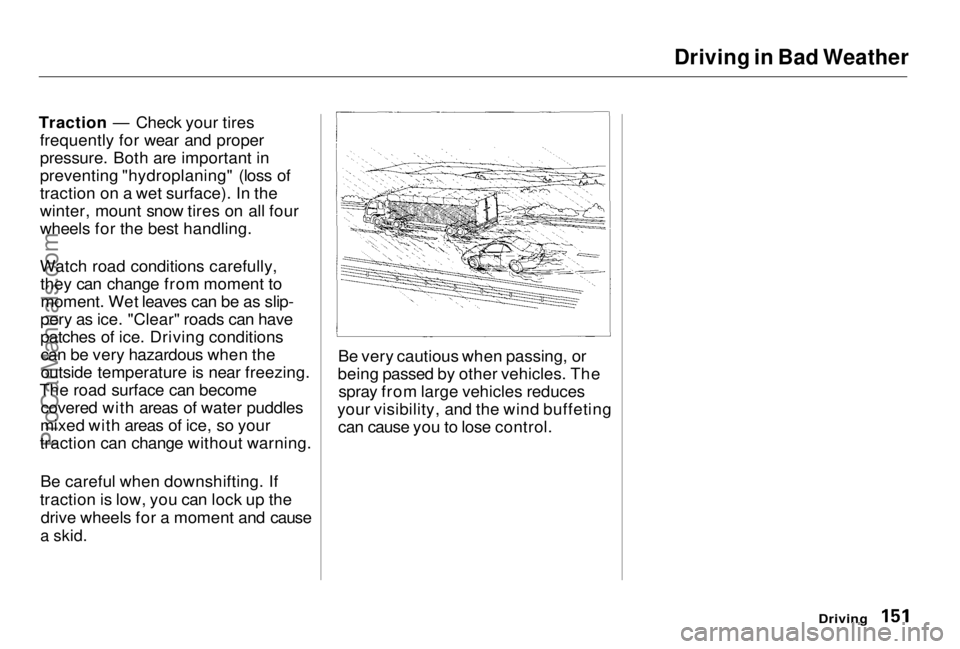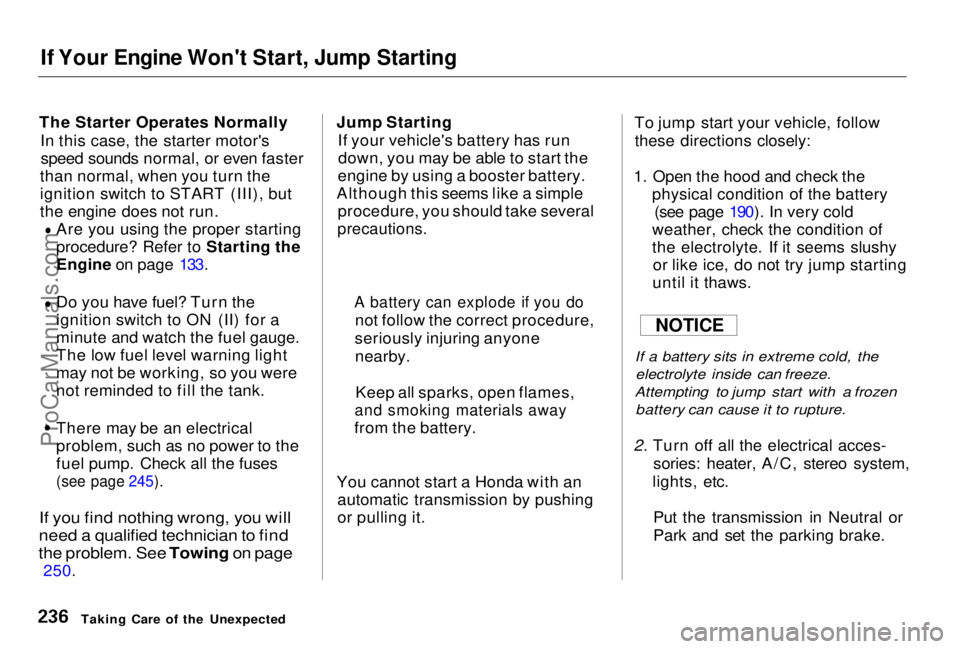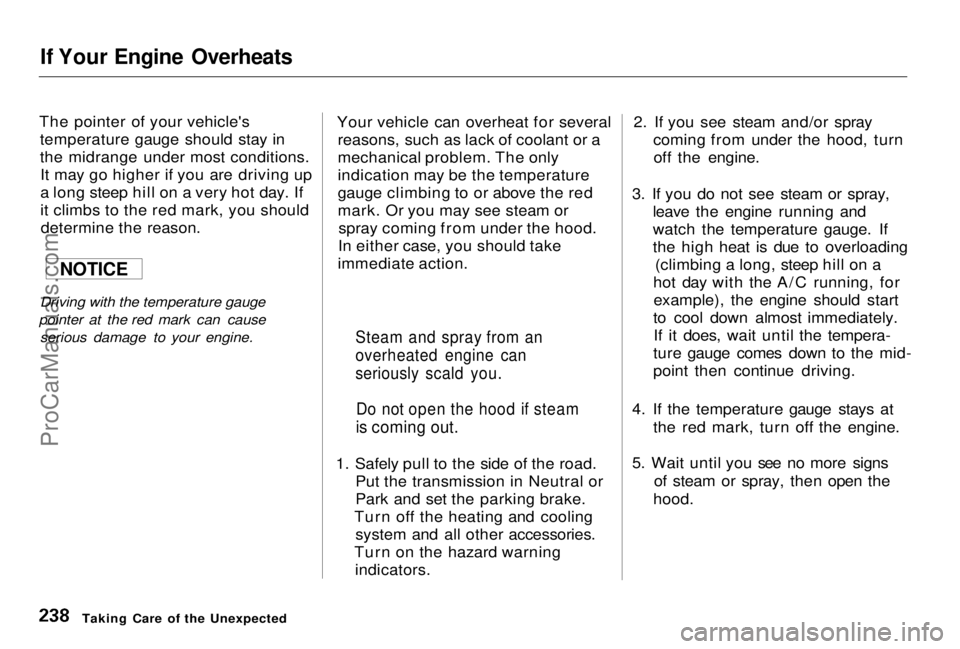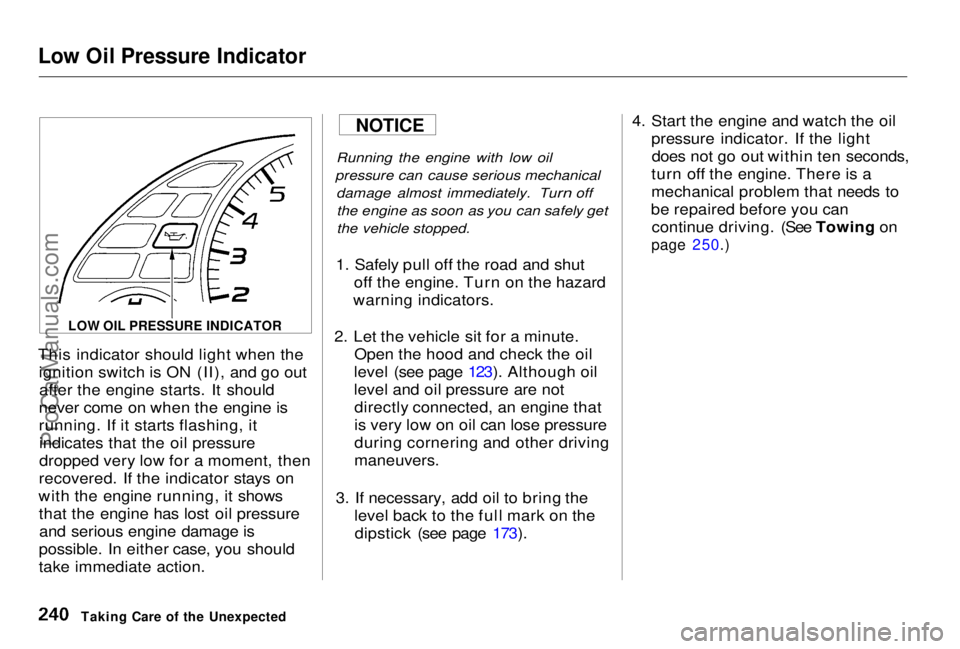warning HONDA PRELUDE 1998 User Guide
[x] Cancel search | Manufacturer: HONDA, Model Year: 1998, Model line: PRELUDE, Model: HONDA PRELUDE 1998Pages: 278, PDF Size: 2.61 MB
Page 151 of 278

Driving in Bad Weather
Traction — Check your tires frequently for wear and proper
pressure. Both are important in
preventing "hydroplaning" (loss of
traction on a wet surface). In the
winter, mount snow tires on all four
wheels for the best handling.
Watch road conditions carefully,they can change from moment tomoment. Wet leaves can be as slip-
pery as ice. "Clear" roads can have
patches of ice. Driving conditions can be very hazardous when the
outside temperature is near freezing.
The road surface can become covered with areas of water puddles
mixed with areas of ice, so your
traction can change without warning.
Be careful when downshifting. If
traction is low, you can lock up the drive wheels for a moment and cause
a skid.
Be very cautious when passing, or
being passed by other vehicles. The spray from large vehicles reduces
your visibility, and the wind buffeting can cause you to lose control.
DrivingProCarManuals.comMain Menu Table of Contents s t
Page 226 of 278

Changing a Flat Tire
If you have a flat tire while driving, stop in a safe place to change it.
Stopping in traffic or on the shoulder
of a busy road is dangerous. Drive slowly along the shoulder until you
get to an exit or an area to stop that is far away from the traffic lanes.
1. Park the vehicle on firm, levelground away from traffic. Turn on
the hazard warning lights and turnthe ignition switch to LOCK (0).
2. Put the transmission in Park (automatic) or Reverse (manual).
Apply the parking brake. Have all of the passengers get out of the
vehicle while you change the tire. 3. Open the trunk. Raise the trunk
floor by lifting up on the back edge.
4. Take the tool kit out of the trunk.
5. Unscrew the wing bolt and take the spare tire out of its well.
CONTINUED
Taking Care of the Unexpected
The vehicle can easily roll off
the jack, seriously injuring anyone underneath.
Follow the directions for
changing a tire exactly, and never get under the vehicle
when it is supported only by the
jack.
JACK
TRUNK
FLOOR
TOOL KIT SPARE
TIREProCarManuals.comMain Menu Table of Contents s t
Page 233 of 278

If Your Engine Won't Start, Jump Starting
The Starter Operates Normally In this case, the starter motor'sspeed sounds normal, or even faster
than normal, when you turn the
ignition switch to START (III), but
the engine does not run. Are you using the proper starting
procedure? Refer to Starting the
Engine on page 133.
Do you have fuel? Turn the
ignition switch to ON (II) for a
minute and watch the fuel gauge.
The low fuel level warning light
may not be working, so you were
not reminded to fill the tank.
There may be an electrical
problem, such as no power to the
fuel pump. Check all the fuses
(see page 245).
If you find nothing wrong, you will
need a qualified technician to find
the problem. See Towing on page
250. Jump Starting
If your vehicle's battery has rundown, you may be able to start the
engine by using a booster battery.
Although this seems like a simple procedure, you should take several
precautions.
You cannot start a Honda with an automatic transmission by pushing
or pulling it. To jump start your vehicle, follow
these directions closely:
1. Open the hood and check the physical condition of the battery(see page 190). In very cold
weather, check the condition of
the electrolyte. If it seems slushy or like ice, do not try jump starting
until it thaws.
If a battery sits in extreme cold, the
electrolyte inside can freeze.
Attempting to jump start with a frozen
battery can cause it to rupture.
2. Turn off all the electrical acces- sories: heater, A/C, stereo system,
lights, etc.
Put the transmission in Neutral or
Park and set the parking brake.
Taking Care of the Unexpected
NOTICE
A battery can explode if you do
not follow the correct procedure,
seriously injuring anyone nearby.
Keep all sparks, open flames,
and smoking materials away
from the battery.ProCarManuals.comMain Menu Table of Contents s t
Page 235 of 278

If Your Engine Overheats
The pointer of your vehicle's temperature gauge should stay in
the midrange under most conditions.It may go higher if you are driving up
a long steep hill on a very hot day. If
it climbs to the red mark, you shoulddetermine the reason.
Driving with the temperature gauge
pointer at the red mark can cause serious damage to your engine. Your vehicle can overheat for several
reasons, such as lack of coolant or a
mechanical problem. The only
indication may be the temperature
gauge climbing to or above the red
mark. Or you may see steam orspray coming from under the hood.
In either case, you should take
immediate action.
1. Safely pull to the side of the road. Put the transmission in Neutral or
Park and set the parking brake.
Turn off the heating and cooling system and all other accessories.
Turn on the hazard warning indicators. 2. If you see steam and/or spray
coming from under the hood, turnoff the engine.
3. If you do not see steam or spray, leave the engine running and
watch the temperature gauge. If
the high heat is due to overloading(climbing a long, steep hill on a
hot day with the A/C running, for example), the engine should start
to cool down almost immediately. If it does, wait until the tempera-
ture gauge comes down to the mid-
point then continue driving.
4. If the temperature gauge stays at the red mark, turn off the engine.
5. Wait until you see no more signs of steam or spray, then open the
hood.
Taking Care of the Unexpected
NOTICE
Steam and spray from an
overheated engine can
seriously scald you.Do not open the hood if steam
is coming out.ProCarManuals.comMain Menu Table of Contents s t
Page 237 of 278

Low Oil Pressure Indicator
This indicator should light when the
ignition switch is ON (II), and go outafter the engine starts. It should
never come on when the engine is
running. If it starts flashing, it indicates that the oil pressure
dropped very low for a moment, then
recovered. If the indicator stays on
with the engine running, it shows that the engine has lost oil pressureand serious engine damage is
possible. In either case, you should
take immediate action.
Running the engine with low oil
pressure can cause serious mechanical damage almost immediately. Turn off
the engine as soon as you can safely get
the vehicle stopped.
1. Safely pull off the road and shut off the engine. Turn on the hazard
warning indicators.
2. Let the vehicle sit for a minute. Open the hood and check the oil
level (see page 123). Although oil
level and oil pressure are not directly connected, an engine that
is very low on oil can lose pressure
during cornering and other driving
maneuvers.
3. If necessary, add oil to bring the level back to the full mark on thedipstick (see page 173). 4. Start the engine and watch the oil
pressure indicator. If the lightdoes not go out within ten seconds,
turn off the engine. There is a
mechanical problem that needs to
be repaired before you can continue driving. (See Towing on
page 250.)
Taking Care of the Unexpected
NOTICE
LOW OIL PRESSURE INDICATOR
ProCarManuals.comMain Menu Table of Contents s t
Page 255 of 278

Tire Information
Traction
The traction grades, from highest tolowest, are A, B, and C, and theyrepresent the tire's ability to stop on
wet pavement as measured under controlled conditions on specified
government test surfaces of asphalt and concrete. A tire marked C may
have poor traction performance.
Warning: The traction grade as- signed to this tire is based on brak-
ing (straight ahead) traction tests and does not include cornering (turning) traction.
Temperature
The temperature grades are A (the
highest), B, and C, representing the
tire's resistance to the generation of
heat and its ability to dissipate heat
when tested under controlled conditions on a specified indoor
laboratory test wheel. Sustained high temperature can cause the materialof the tire to degenerate and reduce
tire life, and excessive temperature can lead to sudden tire failure. The
grade C corresponds to a level of
performance which all passenger car
tires must meet under the Federal Motor Vehicle Safety Standard No. 109. Grades B and A represent
higher levels of performance on the
laboratory test wheel than the minimum required by law. Warning: The temperature grade for
this tire is established for a tire thatis properly inflated and not over-
loaded. Excessive speed, underinfla-
tion, or excessive loading either separately or in combination, can
cause heat build-up and possible tire
failure.
Technical InformationProCarManuals.comMain Menu Table of Contents s t
Page 272 of 278

Index
Emergency Brake............................ 84
Emergency Flashers....................... 63
Emission Controls......................... 261
Engine
Coolant Temperature Gauge ..... 57
Malfunction Indicator Lamp................................. 53, 242
Oil Pressure Indicator......... 53, 240
Oil, What Kind to Use............... 173
Overheating................................ 238
Specifications............................. 254
Ethanol in Gasoline ....................... 259
Evaporative Emission Controls.... 261
Exhaust Fumes................................ 47
Expectant Mothers, Use of Seat Belts by.........................................17
Exterior, Cleaning the................... 220
Fabric, Cleaning............................. 222
Fan, Interior...................................... 92
Features, Comfort and Convenience................................. 91
Filling the Fuel Tank..................... 121 Filters
Air................................................187
Oil................................................175
First Gear, Shifting........................ 142 5-speed Manual Transmission Checking Fluid Level................ 184
Shifting the................................. 134
Flashers, Hazard Warning.............. 63
Flat Tire, Changing a.................... 229
Fluids Automatic Transmission........... 183
Brake...........................................185
Clutch..........................................186
Manual Transmission............... 184
Power Steering........................... 186
Windshield Washer................... 182
FM Stereo Radio
Reception.................................... 105
Folding Rear Seat............................ 79
Foreign Countries, Driving in...... 260 Four-way Flashers........................... 63
Front End, Towing by
Emergency Wrecker................. 250
Fuel..................................................120
Fill Door and Cap....................... 121
Gauge............................................ 57
Octane Requirement................. 120
Oxygenated................................ 259
Reserve Indicator......................... 55
Tank, Filling the......................... 121
Fuses, Checking the...................... 245
Gas Mileage, Improving................ 125
Gasohol........................................... 259
Gasoline.......................................... 120 Fuel Reserve Indicator................ 55
Gauge............................................ 57Octane Requirement................. 120
Tank, Filling the......................... 121
Gas Station Procedures................. 121
Gauges
Engine Coolant Temperature .... 57
Fuel................................................57
Gearshift Lever Positions Automatic Transmission........... 137
5-speed Manual
Transmission.......................... 134
Glass Cleaning............................... 223
Glove Box......................................... 74ProCarManuals.comMain Menu s t
Page 273 of 278

Index
Halogen Headlight Bulbs.............. 206
Hazard Warning Flashers............... 63
Headlights
Aiming......................................... 205
Daytime Running Lights............. 60
High Beam Indicator................... 60
High Beams, Turning on............ 60
Low Beams, Turning on ............. 60
Reminder Chime.......................... 60
Replacing Halogen Bulbs ......... 206
Turning on.................................... 60
Head Restraints............................... 77
Heating and Cooling........................ 92
High Altitude, Starting at.............. 133
High-Low Beam Switch .................. 60
High-mount Brake Light............... 213
Hood, Opening the ........................ 122
Horn................................................... 59
Hot Coolant, Warning About........ 177
Hydraulic Clutch............................ 186
Hydroplaning.................................. 151 Identification Number, Vehicle.... 252
If Your Car Has to be Towed....... 250
Ignition Keys............................................... 68
Switch............................................ 70
Timing Control System............. 262
Immobilizer System......................... 69
Indicator Lights, Instrument Panel.............................................. 51
Infant Restraint................................ 19 Inflation, Proper Tire ....................
197
High Speed
Driving................... 257
Normal Driving.......................... 198
Inside Mirror.................................... 83
Inspection, Tire.............................. 198
Instrument Panel............................. 50
Instrument Panel Brightness......... 61
Interior Cleaning............................ 222
Interior Lights.................................. 89
Introduction.........................................
i
Jacking up
the Car......................... 231
Jack, Tire........................................ 230
Jump Starting................................. 236
Keys................................................... 68
Label, Certification........................ 252
Lane Change, Signaling.................. 61
Lap/Shoulder Belts......................... 40Leaking of Exhaust into Car.......... 47
Learning Key.................................... 69
Lights Bulb Replacement..................... 206
Indicator........................................ 51
Parking.......................................... 60
Turn Signal................................... 61
Loading Cargo................................ 128
LOCK (Ignition Key Position)....... 71
CONTINUEDProCarManuals.comMain Menu s t
Page 277 of 278

Index
Transmission
Checking Fluid Level,Automatic............................... 183
Checking Fluid Level,
Manual....................................184
Fluid Selection............................ 183
Identification Number............... 253
Shifting the Automatic.............. 136
Shifting the Manual................... 134
Treadwear...................................... 257
Trip Meter........................................ 56
Trunk................................................. 73
Opening the..................................
73
Open Monitor
Light.................... 55
Turn Signals..................................... 61
Underside, Cleaning...................... 224
Unexpected, Taking Care
of the........................................... 227
Uniform Tire Quality Grading..... 257
Unleaded Gasoline......................... 120
Upholstery Cleaning...................... 222
Used Oil, How to Dispose of........ 176 Vehicle Capacity Load .................. 129
Vehicle Dimensions....................... 254
Vehicle Identification Number..... 252
Vehicle Storage.............................. 217
Ventilation.........................................95
VIN..................................................252
Vinyl Cleaning................................ 222
Viscosity, Oil................................... 174
Warning Beepers
Headlights on............................... 60
Key in Ignition.............................. 71
Seat Belts........................................ 6
WARNING, Explanation of.............. ii
Warning Labels, Location of.......... 48 Warranty Coverages*................... 269
Washer, Windshield Checking the Fluid Level......... 182
Operation...................................... 63
Washing.......................................... 220
Waxing and Polishing................... 221
Wheels
Adjusting the Steering................ 64
Alignment and Balance............. 199
Compact Spare........................... 228
Wrench.......................................230
Windows Cleaning...................................... 223
Operating the Power................... 80
Rear, Defogger............................ 63
Windshield
Cleaning........................................ 62
Defroster...................................... 98
Wipers, Windshield Changing Blades........................ 193
Operation...................................... 62
Worn Tires..................................... 198
Wrecker, Emergency Towing...... 250
* U.S. and Canada onlyProCarManuals.comMain Menu s t